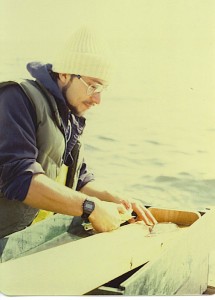 A while back I wrote a post called Reconstructing Bermuda in which I reminisced about my college semester on that Atlantic Ocean island. In an attempt to sound scholarly, here is Part Deux.
A while back I wrote a post called Reconstructing Bermuda in which I reminisced about my college semester on that Atlantic Ocean island. In an attempt to sound scholarly, here is Part Deux.
Many years ago I lived in Bermuda for a college semester. There were 15 of us learning how to be marine biologists while living at the Bermuda Biological Station for Research. For two months we studied, we dived, we snorkeled, we spent hours bent over equipment in the laboratory searching for microscopic parasites. Fun was had by all.
That’s how I began the previous post and it’s fitting to use it to set the stage. I’ve written more on trials and travails of that semester on my memoir/creative blog, Hot White Snow. Here are some additional highlights (click on the titles or “Read more” for the full article):
My independent research project for the semester focused on the epibiota of the submerged roots of red mangroves in Walsingham Pond. Red mangroves (Rhizophora mangle) are best known for their aerial prop roots, which help suspend the main trunk and leaves of the tree above the water. Epibiota are those animals and plants that attach themselves to the roots, either permanently or temporarily. In my survey I identified thirty-four different species of attached flora (plants) and fauna (animals). For contrast I also examined the nearby bay, which led to the following encounter with an inquisitive barracuda. [Read more]
The Barracuda of Walsingham Bay, Bermuda
Each of us were required to do a field research project of our own design. Mine was to examine the epibiota on mangrove roots in Walsingham Pond, with a comparison site in Walsingham Bay. I gathered data by snorkeling around both locations and writing my findings on waterproof tablets (the plasticized paper kind, long before iPad-type tablets). A barracuda full of teeth and curiosity followed me around the Bay. It was unnerving, and yet at the same time exhilarating. [Read more]
Picture 15 people walking into a local bar, all wearing bright purple t-shirts. Needless to say, we attracted a lot of attention, including from one very lonely sailor and a restroom encounter ending with “Are you all some kind of group?” And that was just the first night. [Read more]
Speaking of bars, our favorite, which we dubbed “The pub is a pub is a pub,” was the scene of one late night beer chugging contest featuring Worthington E on tap. Most of my companions assumed I was a lightweight drinker, but the Worthington E slid down the gullet so easily I found myself in the finals against one of the women in the group. Who won? [Read more] [And no, this was not the reason for the next story]
Bailey’s Bay Slide
Our main mode of transportation around the island was by small motor scooters called moped. While seemingly innocuous, they played central roles in several incidents, including one that makes my knee throb to this day. One day after a light rain we set out on a research expedition that turned out to be more eventful than we anticipated. This is why. [Read more]
North Rock sits an 8-mile boat ride from the lab. After a day of diving and snorkeling we kept ourselves entertained working on our tans and singing an old sea ballad. Officially “The Mermaid,” the fifteen of us turned the chanty into our “North Rock” anthem. [Read more]
I have many more fond memories of that time and have reconnected with a few of my fellow explorers in recent years, so expect to see more reminiscing in the future.

Lincoln: The Fire of Genius is available for purchase at all bookseller outlets. Limited signed copies are available here. The book is also listed on Goodreads, the database where I keep track of my reading. Click on the “Want to Read” button to put it on your reading list. If you read the book, please leave a review and/or rating.
You also follow my author page on Facebook.
David J. Kent is President of the Lincoln Group of DC and the author of Lincoln: The Fire of Genius: How Abraham Lincoln’s Commitment to Science and Technology Helped Modernize America and Lincoln: The Man Who Saved America.











Pingback: Revisiting Hanoi…and More | Science Traveler